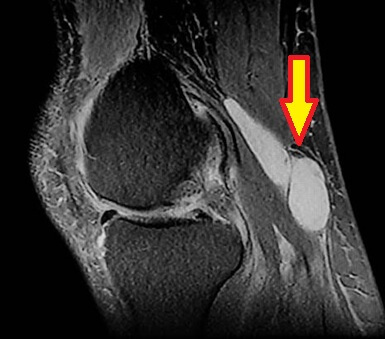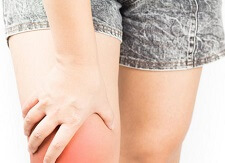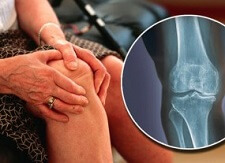- Home
- Common Knee Conditions
- Bursitis
- Bakers Cyst
Bakers Cyst
Written By: Chloe Wilson, BSc(Hons) Physiotherapy
Reviewed by: KPE Medical Review Board
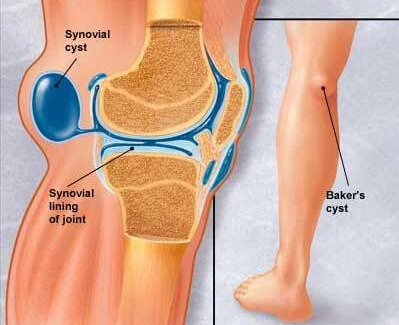
A Bakers Cyst is the most common cause of swelling, pain and stiffness behind the knee.
At the back of the knee is the popliteal bursa - a small fluid filled sac that sits between the hamstring muscle tendons and knee bones to reduce friction.
Inflammation of the popliteal bursa was first discovered in the 19th century by Dr William Morrant Baker, which is where is gets the name Bakers Cyst. It is also known as semimembranosus bursitis or a popliteal cyst.
Popliteal cysts are most common over the age of 40 and tend to affect women more than men.
Here we will look at the causes and classic symptoms of a Bakers Cyst, the best treatment options and how to prevent the inflammation from returning in the future. If this doesn't sound like your problem, check out other causes of swelling behind the knee.
What Causes A Bakers Cyst?
A Bakers cyst is caused by excess fluid in the knee joint. As the joint swells, excess synovial fluid seeps backwards out of the joint and into the popliteal bursa. As the fluid enters the bursa it starts to swell resulting in bursitis.
A number of things can cause the swelling of the knee that leads to a Bakers Cyst:
- Osteoarthritis: wear and tear of the knee bones and cartilage leads to increased fluid in the knee joint. 50% of arthritis sufferers develop a Bakers cyst at some point. Knee arthritis is by far the most common cause of Bakers cysts.
- Knee Injuries: any injury that results in swelling inside the knee joint increases the risk of developing a popliteal bursitis. The most common injury to cause a Bakers cyst is a cartilage tear.
- Inflammatory Arthritis: There are a few types of inflammatory arthritis that increase the risk of developing a Bakers cyst, the most common being gout.
Symptoms of a Bakers Cyst
The first symptom people tend to feel with a bakers cyst is a small bulge behind the knee, a bit like a small water balloon or squashy orange.
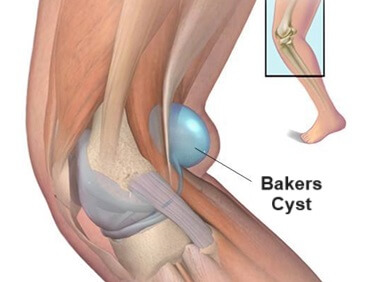
There may only be minor swelling and often a Bakers cyst is so small you don’t even notice anything.
The average size of a Bakers cyst is 3cm.
In some cases however, the popliteal cyst can get quite large, resulting in pain behind the knee, tightness and stiffness, especially when you bend and straighten the knee. A Bakers cyst is the most common cause of swelling behind the knee.
The pain associated with a popliteal cyst tends to get worse with activity or when standing for long periods, easing with rest.
Diagnosing A Popliteal Cyst
Diagnosis of a popliteal cyst is usually made by your doctor from what you tell him and what he can see.
If there is any doubt the doctor can confirm the diagnosis of a Bakers Knee Cyst by performing an ultrasound or MRI scan.
The symptoms of a ruptured popliteal cyst can be similar to those of a DVT
(a blood clot in the leg). If you experience pain in your calf
accompanied by any swelling, redness or heat, see your doctor immediately.
Treatment Options
There are a number of different treatment options when it comes to a bakers cyst including:
#CommissionsEarned from Amazon on qualifying purchases
1. Ice
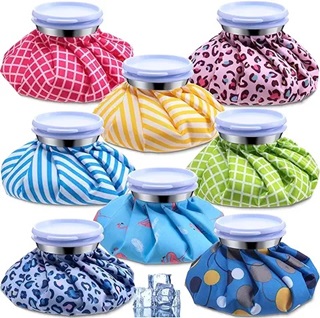
Ice treatment helps to reduce the swelling in the knee and the bursa, which will help to reduce the pain.
Ice needs to be applied correctly however otherwise it can actually make things worse. In the ice wrap section we look at all the different ways to apply ice and which ones are most effective at reducing bakers cyst swelling.
2. Medication
Non-steroidal anti-inflammatory Drugs (NSAIDs) e.g. ibuprofen/Advil can help to reduce pain and swelling with popliteal bursitis, but they should only ever be taken on advice of the doctor due to the potential side effects.
3. Stretching Exercises
Tightness in the muscles around the knee aggravates a Popliteal Cyst by squashing it which can lead to further inflammation. Knee stretches can therefore be a very effective way of resolving the condition.
In the Bakers Cyst Stretches section we look at the best exercises to reduce the pressure behind the knee which helps to both treat and prevent further episodes of popliteal bursitis.
4. Aspiration
If a bakers cyst is particularly large or is causing pain behind the knee, then the excess fluid can be drained with a needle by your doctor. It is a very simple procedure and usually provides instant relief.
However, it is very common for the fluid to re-accumulate in the bursa if the underlying cause of the bursitis is not address – see Preventing Recurrence below for tips on how to avoid this.
5. Injections
Knee bursitis often responds well to cortisone injections. This is where your doctor injects a mixture of steroid and local anaesthetic into the knee which works to reduce the swelling and reduce the pain behind the knee.
Again, the benefits are usually fairly instant but are often short lived as the swelling returns. Find Out More >
6. Pulsed Electromagnetic Energy (PEME)
Pulsed electromagnetic energy, aka short wave diathermy, is a form of electrotherapy can help to reduce the inflammation.
PEME is
usually carried out by a physiotherapist. It can take a few sessions to notice the benefits but I have certainly found this to be an
effective treatment with a number of people suffering from a bursitis.
7. Surgery
Whilst not usually necessary, in a minority of cases, surgery may be recommended. This is usually the case if the popliteal cyst is a result of long-term damage in the knee e.g. a cartilage tear or arthritis
Preventing Recurrence
Bakers Cysts frequently return, especially in people suffering from arthritis due to the continued production of excess fluid in the knee joint.
Knee strengthening exercises and knee stretches can often help to prevent a popliteal cyst returning. The stronger the muscles get, the less force goes through the bones making it less likely that the knee will swell which therefore prevents another knee cyst from developing. This is especially the case when the popliteal cyst has developed due to knee arthritis.
Possible Complications
Occasionally, a Bakers Knee Cyst bursts. The fluid from inside the bursa typically leaks down the back of the leg and into the calf area.This can cause swelling and/or a sharp pain in the calf.
The free fluid will gradually be reabsorbed into the body but this can take up to a month. Pain medication e.g. paracetamol/Acetaminophen can be used to alleviate any discomfort after the bakers cyst bursts.
Common Questions
Where Does The Name Baker Cyst Come From?
Where Does The Name Baker Cyst Come From?
A Baker’s Cyst gets its name from the surgeon who first wrote about the condition, Dr William Morrant Baker (1838-1896). He was an English physician and surgeon.
Is a Baker’s Cyst Dangerous?
Is a Baker’s Cyst Dangerous?
A Baker’s Cyst gets its name from the surgeon who first wrote about the condition, Dr William Morrant Baker (1838-1896). He was an English physician and surgeon.
What Causes A Baker's Cyst To Burst?
What Causes A Baker's Cyst To Burst?
Excessive swelling or pressure on the bursa can cause a Baker's Cyst to burst. When a Baker's cyst ruptures, the fluid seeps down into the calf causing a sharp pain in the calf. The calf may also become red, swollen and tight. A ruptured popliteal cyst can be extremely painful.
Is Draining A Bakers Cyst Painful?
Is Draining A Bakers Cyst Painful?
If a bakers cyst is extremely painful or persistent, your doctor may want to drain the fluid with a needle. It is a fairly painless procedure – just a slight prick as the needle penetrates the skin. You may also be given a steroid injection to reduce swelling. In some cases, the fluid returns.
How Do You Get Rid Of A Baker's Cyst?
How Do You Get Rid Of A Baker's Cyst?
To get rid of Baker’s cyst, there are ways of reducing the short term pain including using ice and anti-inflammatory medications. To avoid recurrence, strengthening the muscles around the knee is important. Stronger muscles mean less force is put through the bones thus reducing the likelihood of swelling and the cyst returning.
What Else Could It Be?
There are other causes of pain and swelling behind the knee besides Bakers Cyst knee, including:
- Calf Tear
- Popliteal Aneurysm
- DVT
- Synovial Sarcoma
If you want some help working out what is causing your pain, visit the pain behind the knee or knee pain diagnosis for help.
There are a number of other bursa located around the knee that can get irritated and inflamed other than a Bakers Cyst:
- Suprapatellar Bursitis: just above the knee in the lower thigh
- Prepatellar Bursitis: right in front of the knee cap
- Infrapatellar Bursitis: just below the knee
- Pes Anserine Bursitis: inner side of the knee
Related Articles
Last Updated: May 6th, 2025
Next Review Due: May 6th, 2027
